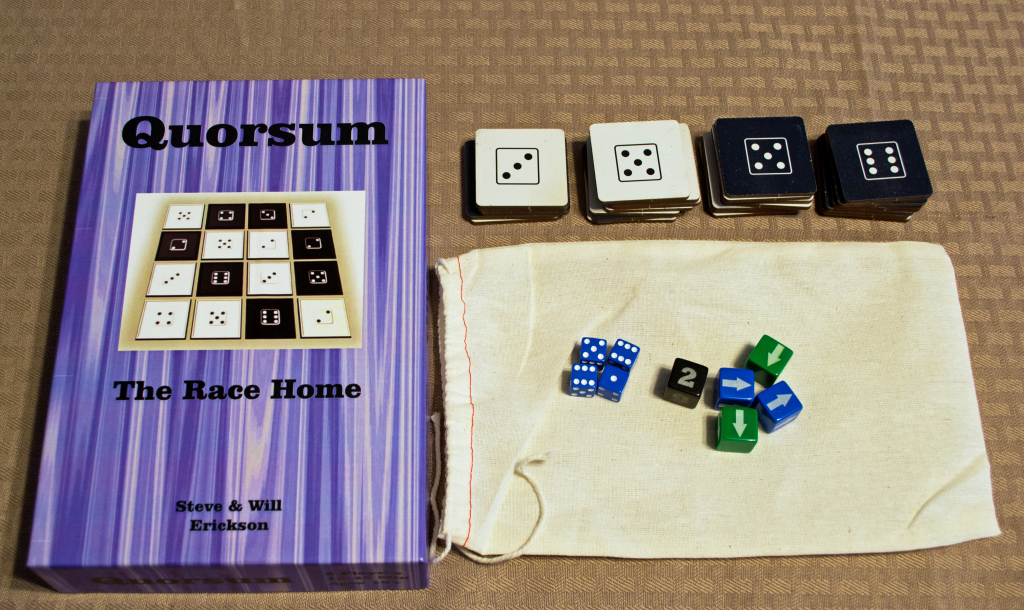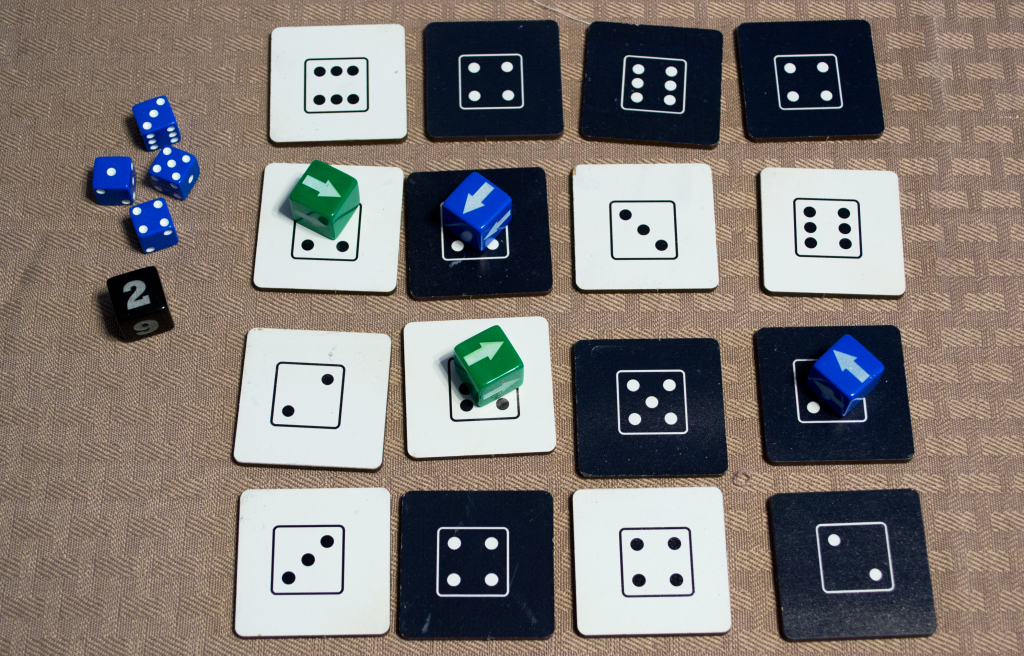It’s not often that an “abstract” game comes across my desk, but the ones I do own, I really enjoy. Most of the abstract games in my collection really spark the synapses and encourage critical thinking, a skill that any parent worth his/her two cents should often strive to develop in their kids. We’re here today to take a look at “Quorsum”, a game that is advertised as abstract (I’ll get to that) and hit virtual shelves just recently. In short, it’s a two player racing/strategy combo game that features both dice and a randomized board layout. Before I get too far ahead of myself however, I’d like to quickly thank game co-designer Steve Erickson for reaching out and introducing me to the game.
Components
Board Tiles – These double-sided board tiles each list a number, valued between two and six. Both sides of a tile list the same value, except one side is colored white while the other side is colored black.
Dice – The game contains four six-sided standard dice.
Pawns – There are four pawns: two blue and two green. Each player will control a specific colored pair throughout the game. While they look like dice, I’ll be referring to them as pawns so as not to confuse them with the actual numbered dice.
Deadlock Cube – This six-sided die keeps track of how many successive turns have gone by that didn’t have net progress. It’s one of the ways the game can end.
Setup & Gameplay
Players will choose a pair of colored pawns and pick sixteen of the twenty-five available tiles, randomly placing them in a 4×4 grid. They’ll then each roll a die: highest roll can decide to either take the first turn OR choose the starting locations of the pawns. The other player will perform whichever option the highest roller didn’t choose. The pawns begin on the corner tiles (one per corner). The corner opposite of a pawn’s starting location is its home tile. The player who manages to get both his/her pawns to their home corner first, wins the game.
A player’s turn can be outlined as follows:
1) Assign Dice – At the start of a player’s turn, they’ll get four dice. It’ll be up to them as to how they assign those dice via the following actions:
Movement: The player can place any number of dice onto an adjacent tile (orthogonally) with the intent on moving there. The tile they move to MUST match the color they’re currently on. A pawn starting on a white corner will always move on white tiles whereas a pawn starting on a black corner will always move on black tiles.
Flipping: The player can place any number of dice onto any vacant tile with the intent on flipping it so that it changes color. A player cannot do this action if the tile was immediately flipped by their opponent on the turn before.
2) Resolve Dice – Once a player has assigned all four dice, they’ll resolve them as follows (in any order they wish):
Movement: When attempting to resolve dice for the sake of moving one of their pawns, they’ll pick up those dice and roll them. The dice that meet or exceed the number of the destination tile remain in play while the others are discarded. The player can opt to move again with the dice remaining in play by picking an adjacent tile and rolling again. This is called “chaining”.
Flipping: When attempting to resolve dice for the sake of flipping, they’ll pick up those dice and roll them. If at least one of the dice meet or exceed the tile in question, it is flipped. The dice used to flip the tile are discarded.
Should a player turn end without any of their pawns moving toward their home base, they’ll rotate the deadlock cube to the next ascending number, starting with “one”. Once a player makes forward progress, the deadlock cube is reset. The player who manages to get their two pawns to their home space first, wins! Likewise, if the deadlock cube reaches its highest value (three consecutive turns for each player with no net progress), a winner is determined by looking to see whose pawns are closest to their home tiles.
The above doesn’t cover all of the rules found in the manual, but should give you an idea as to how the game is played. For more details, you can check out the rule book here:
http://quorsum1.wix.com/quorsum#!rulebook/c158d
The Review
“Quorsum” falls into the category of “easy to learn, difficult to master”. As cliché’ as that sounds, it’s not difficult to master in the sense that you’d expect. Games like “Othello” and “Chess” give players full control over their own piece movement…that is, they don’t have the roll dice to see IF they can move a particular piece. “Quorsum” is still a thinking game, don’t get me wrong, but there’s an equal emphasis on playing the odds. This style of gameplay can make the outcome unpredictable despite a player’s best intentions, making it difficult to master. Still confused? Allow me to explain…
It’s your turn. You have one pawn already on its home space with the other on its way. Unfortunately for you, the path leading to your home space is made up of fives and sixes. Further, your opponent makes it a point to use half of his/her dice to flip one of the spaces along your path while making their way home. You decide to assign two dice to flipping the space in front of you and the other two for movement. Unfortunately, your dice rolls for the flipping weren’t high enough, making movement relatively moot. Long story short: if the dice are unkind, you’re going to have a heck of a time getting anywhere.
With that said, “Quorsum” is fantastic at what it does in that it gives the player choices without overloading the brain. You can choose to play offensively and get your pawns home as quickly as possible or play defensively and mess with your opponent by blocking his movement via flipping or your own pawns (only one pawn can occupy a space). Sometimes the rolls will work against you no matter what you do, but you can minimize how often that happens by assigning most/all of your dice to a particular space/action. It can be frustrating when you can’t seem to make any headway, but the feeling of successfully chaining a pawn across four spaces can be equally as rewarding.
Is “Quorsum” really an abstract game, however? While it advertises itself as such on the game’s official website, the fact that it features the rolling of dice made me scratch my head a bit. According to Wikipedia, an abstract game is defined as something that “minimizes luck” and “which there is no hidden information, no non-deterministic elements (such as shuffled cards or dice rolls), and (usually) two players or teams taking a finite number of alternating turns.” Based on my experiences, I wouldn’t classify this game as a true and true abstract game (mainly due to the dice rolling), though it admittedly borrows a lot of the elements from the definition.
Overall, “Quorsum” is one of the most interesting strategy games that I’ve ever played. I like “Blokus” and “Convert” for their “Chess-like” qualities in that skill usually determines a winner. “Quorsum” didn’t feel like more of the same in that regard, which is refreshing considering the amount of strategy games I cover. Games are very quick, making it ideal for school nights as well as a filler in between longer play sessions. I’m told that the price will be around $30-$35 at launch, though this may change depending on the retailer. Honestly, this is more than a bit pricey for the content it offers, I feel. Other popular games like “Power Grid” can be found on Amazon for the same price and they happen to feature many, many more components. “Quorsum” is fun and pretty unique, don’t get me wrong, but not worth more than $15-$20 (in my opinion). My suggestion is to wait for a sale if money is currently tight. Otherwise, have at it!
Final Verdict: 8/10
—
You can learn more about “Quorsum” by visiting the official website, here:
http://quorsum1.wix.com/quorsum
—


